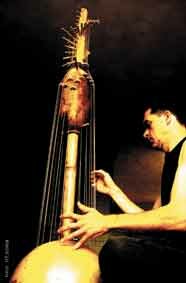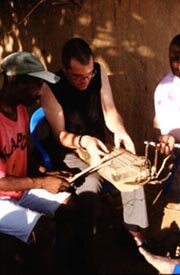




Steadily building an impressive array of musical instruments since the early 90's, Gama experiments with the phenomenon of metamorphosis of instruments and musical crafts that span the period from pre-historical times to our days. By introducing the construction of the instrument into the writing process, Gama adds new elements that become part of the piece being composed.
In Pangeia Instrumentos he uses the notion of object as a form of writing and score. Thus, the exercise of "giving form" or "writing through form" becomes a central concept in his work. While drawing inspiration from his own native Angolan folk music and instruments, as well as those from throughout the African Diaspora his work as a composer further elaborates on the potential to transform beyond the structures of tradition.
The sound palette he creates on these beautiful sonic sculptures are hypnotic and otherworldly: percussive loops and string arpeggios built from the barest of components that square the circle between Gamelan music, the work of turn of the century composers such as Eric Satie, and the music of the twentieth century minimalists Steve Reich, Michael Nyman or Arvo Part.
Although high on his list of references are composers such as Francis Bebey, Egberto Gismonty or Nana Vasconcelos with whom he has recently toured in Southern Africa his music is unique and "what breathes through his compositions is the silence and space of desert(ed) terrains, landscapes populated by no-one but traversed by nomads; geographies beyond ordinary human time..."
Gama's installations and exhibitions are an attempt at creating a space where the listener witnesses and experiments a topography of music, its body and its orientation, a concept slightly reminiscent of John Cage's theatre of music where the listener can hear, see and touch. Among several albums and recordings for dance and film are his latest release Pangeia Instrumentos on Rephlex , and Oceanites Erraticus on PangeiArt.